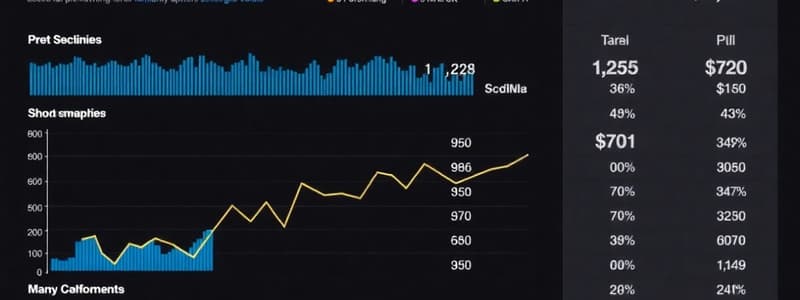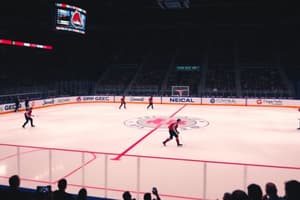Podcast
Questions and Answers
What are the two performance indicators used to predict the later half of the NHL season?
What are the two performance indicators used to predict the later half of the NHL season?
- Goalie save percentage and penalty minutes
- Player statistics and team rankings
- Total goals and assists
- Win percent and Pythagorean winning percent (correct)
What is the first step taken in the process described in the Notebook?
What is the first step taken in the process described in the Notebook?
- Splitting the data into subsets
- Dropping unnecessary columns from the DataFrame
- Comparing two forecasting models
- Importing the NHL dataset (correct)
Which time frame is used to fit the regression model?
Which time frame is used to fit the regression model?
- First half of the 2016 NHL regular season (correct)
- All games played in October
- Full 2016 NHL regular season
- First half of the 2017 NHL regular season
Why is the order of the data significant when splitting it?
Why is the order of the data significant when splitting it?
Which dataset is being utilized in the analysis?
Which dataset is being utilized in the analysis?
What approach is used to validate the model after fitting it?
What approach is used to validate the model after fitting it?
What must be done before splitting the data?
What must be done before splitting the data?
How is the first half of the NHL regular season defined in the analysis?
How is the first half of the NHL regular season defined in the analysis?
What is the approximate Pythagorean winning percentage from the first half of the regular season?
What is the approximate Pythagorean winning percentage from the first half of the regular season?
What information is necessary to calculate Pythagorean winning percentages?
What information is necessary to calculate Pythagorean winning percentages?
Which model is indicated to fit the data better based on the content?
Which model is indicated to fit the data better based on the content?
What limitation does winning percentages have compared to Pythagorean winning percentages?
What limitation does winning percentages have compared to Pythagorean winning percentages?
Based on the content, which statement is true?
Based on the content, which statement is true?
What column is primarily used to split the data for forecasting?
What column is primarily used to split the data for forecasting?
Which year’s data is used for extracting games in the first half of the regular season?
Which year’s data is used for extracting games in the first half of the regular season?
What statistical measures are created for each team using the team level data set?
What statistical measures are created for each team using the team level data set?
What is the purpose of merging the data frames?
What is the purpose of merging the data frames?
What data set is used as the basis for forecasting?
What data set is used as the basis for forecasting?
What is missing from the data frame after aggregating team statistics?
What is missing from the data frame after aggregating team statistics?
Which command is mentioned as useful for aggregating statistics?
Which command is mentioned as useful for aggregating statistics?
What will be used for forecasting the later half of the regular season?
What will be used for forecasting the later half of the regular season?
What is the primary purpose of building a forecasting model in this context?
What is the primary purpose of building a forecasting model in this context?
Why is it not possible to use the Pythagorean winning percent to predict game results in real-world settings?
Why is it not possible to use the Pythagorean winning percent to predict game results in real-world settings?
What is the implication of using the term 'predict' in statistics compared to everyday language?
What is the implication of using the term 'predict' in statistics compared to everyday language?
Which method is suggested for using the Pythagorean winning percent to forecast a team's future performance?
Which method is suggested for using the Pythagorean winning percent to forecast a team's future performance?
What type of outcome variables do logistic regression models primarily deal with?
What type of outcome variables do logistic regression models primarily deal with?
In the context of forecasting, what does the term 'fit' refer to?
In the context of forecasting, what does the term 'fit' refer to?
What does the forecasting model ensure when predicting results?
What does the forecasting model ensure when predicting results?
Which statement accurately describes the concept of forecasting in a statistical context?
Which statement accurately describes the concept of forecasting in a statistical context?
What is the main goal of using winning percentages from the second half of the regular season?
What is the main goal of using winning percentages from the second half of the regular season?
What is the first step before calculating the winning percentages in the later half of the season?
What is the first step before calculating the winning percentages in the later half of the season?
Which of the following will be included in the resulting DataFrame after the calculations?
Which of the following will be included in the resulting DataFrame after the calculations?
What type of relationship is established between the winning percentages for the first and second halves of the season?
What type of relationship is established between the winning percentages for the first and second halves of the season?
What should be done after calculating the win percent for the later half of the regular season?
What should be done after calculating the win percent for the later half of the regular season?
What is the purpose of plotting the variables before fitting the regression model?
What is the purpose of plotting the variables before fitting the regression model?
Which of the following is NOT one of the columns in the resulting DataFrame used for regression?
Which of the following is NOT one of the columns in the resulting DataFrame used for regression?
Which winning percentage is NOT required for the analysis in the second half of the season?
Which winning percentage is NOT required for the analysis in the second half of the season?
What is the regression coefficient for the winning percentages from the first half of the regular season?
What is the regression coefficient for the winning percentages from the first half of the regular season?
What does an R-squared value of 0.246 indicate?
What does an R-squared value of 0.246 indicate?
Which variable is used as the dependent variable in both regression models?
Which variable is used as the dependent variable in both regression models?
What was the R-squared value for the regression model using the Pythagorean winning percentages?
What was the R-squared value for the regression model using the Pythagorean winning percentages?
How much variance in the dependent variable is explained by the Pythagorean winning percentages model?
How much variance in the dependent variable is explained by the Pythagorean winning percentages model?
Why is the regression coefficient from the Pythagorean model significant?
Why is the regression coefficient from the Pythagorean model significant?
What relationship is observed between the winning percentages from the first and second halves according to the second model?
What relationship is observed between the winning percentages from the first and second halves according to the second model?
What is the statistical significance level mentioned for the regression coefficient in the first model?
What is the statistical significance level mentioned for the regression coefficient in the first model?
Flashcards
Prediction in everyday context
Prediction in everyday context
Predicting the outcome of an event before it occurs.
Prediction in statistics
Prediction in statistics
Using a model to estimate the outcome of an event based on available data.
Pythagorean winning percentage
Pythagorean winning percentage
A statistic calculated using a team's wins and losses. It estimates a team's true strength.
Goal of forecasting
Goal of forecasting
Signup and view all the flashcards
Simple forecasting model for team performance
Simple forecasting model for team performance
Signup and view all the flashcards
Forecasting model
Forecasting model
Signup and view all the flashcards
Predictive model
Predictive model
Signup and view all the flashcards
Reliable forecasting model
Reliable forecasting model
Signup and view all the flashcards
Data Splitting
Data Splitting
Signup and view all the flashcards
Forecasting
Forecasting
Signup and view all the flashcards
Team Level Data
Team Level Data
Signup and view all the flashcards
First Half Regular Season
First Half Regular Season
Signup and view all the flashcards
Later Half Regular Season
Later Half Regular Season
Signup and view all the flashcards
Feature Selection
Feature Selection
Signup and view all the flashcards
Data Manipulation
Data Manipulation
Signup and view all the flashcards
Splitting data into subsets
Splitting data into subsets
Signup and view all the flashcards
Predicting performance using past results
Predicting performance using past results
Signup and view all the flashcards
Winning percentage
Winning percentage
Signup and view all the flashcards
Regular season schedule
Regular season schedule
Signup and view all the flashcards
Later half of the regular season
Later half of the regular season
Signup and view all the flashcards
Pythagorean Model
Pythagorean Model
Signup and view all the flashcards
Winning Percentage Model
Winning Percentage Model
Signup and view all the flashcards
Training and Evaluation
Training and Evaluation
Signup and view all the flashcards
Forecasting Performance
Forecasting Performance
Signup and view all the flashcards
Dependent Variable
Dependent Variable
Signup and view all the flashcards
Data Merging
Data Merging
Signup and view all the flashcards
Scatter Plot
Scatter Plot
Signup and view all the flashcards
Positive Linear Relationship
Positive Linear Relationship
Signup and view all the flashcards
Regression Model
Regression Model
Signup and view all the flashcards
Model Comparison
Model Comparison
Signup and view all the flashcards
Predictive Model for Sports Performance
Predictive Model for Sports Performance
Signup and view all the flashcards
R-squared Value
R-squared Value
Signup and view all the flashcards
Statistically Significant Regression Coefficient
Statistically Significant Regression Coefficient
Signup and view all the flashcards
Explained Variance
Explained Variance
Signup and view all the flashcards
Study Notes
Logistic Regression Models
- Logistic and other regression models are used extensively to predict game outcomes.
- These models are crucial for forecasting game results.
Forecasting Model Fundamentals
- Forecasting in real-world settings involves predicting future events.
- The Pythagorean winning percentage can be used as an independent variable to predict outcomes.
- Using the Pythagorean winning percentage as a predictor doesn't allow prediction in the usual sense. This is because the Pythagorean winning percentage is calculated using scores, which are known only after the event occurs.
- For effective forecasting, we must predict events before they happen.
- Building accurate forecasts requires using available data as indicators of future outcomes.
Pythagorean Winning Percentage
- The Pythagorean winning percentage is a useful statistic.
- It's calculated to accurately represent how well a team is performing (e.g., games won vs games played).
- To predict future game outcomes, use Pythagorean winning percent from the first half of the season as a predictor.
Forecasting Model Validation
- Split data into two subsets
- First half for training (2016 season) and second half (2017 season) for testing.
- The model is trained using the first-half data, and the second half's performance is used to evaluate accuracy.
Building the Forecasting Model
- Import necessary libraries.
- Data preparation for the model: drop unnecessary columns.
- Splitting the dataset into training and test sets.
- Calculate winning percentages, Pythagorean winning percentages using team-level statistics.
- Forecasting model training.
- Performance validation.
- Compare with other measures (winning percentages)
Model Comparison
- Compare Pythagorean winning percent model with simple winning percentage model.
- This comparison is done to show how well the Pythagorean winning percentage model predicts outcomes compared to a simpler approach using just the winning percentage.
- The R-squared values and regression coefficients from each model can be compared.
- Pythagorean winning percentage is more effective than simply using the winning percentage alone to predict outcomes.
Studying That Suits You
Use AI to generate personalized quizzes and flashcards to suit your learning preferences.
Related Documents
Description
This quiz tests your knowledge on the performance indicators and analytical methods used to predict outcomes in the NHL season. It covers topics such as regression modeling, data splitting significance, and Pythagorean winning percentages. Perfect for anyone interested in sports analytics!




